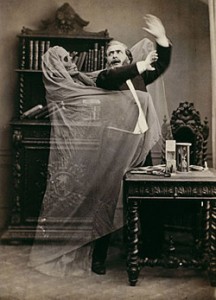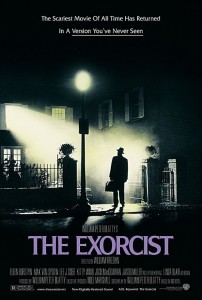
This summer, I decided to test out some of my new research interests in the paranormal, monsters, horror, and religion on my poor-unsuspecting-can’t-I-just-graduate-already? students. We read Joseph Laycock’s “The Folk Piety of William Peter Blatty: The Exorcist in the Context of Secularization” to discuss how an artifact of popular culture emerged as folk religion/piety. Laycock smartly uses the reaction to the film by movie-goers, the press, and religious movements and individuals to problematize narratives of secularization. He poses the question: Why there is a supernatural turn at the supposed height of secularization theory? What follows then is a profile of Blatty, the reception of the film, and discussions about the American practice of exorcism. Laycock documents the “very conscious fear of demons and the supernatural” (5) that emerges as well as the increasing interest/belief in the paranormal.
Much like other works on religion and horror, Laycock attempts to get to the root of cultural fear and the fervent belief in the paranormal. Why do Americans purport belief in ghosts, demons, and other supernatural agents? What does our research look like if we apply Robert Orsi’s “abundant empiricism” to this supernaturalism? Or apply Orsi’s critique of religion-as-belief to the studies of the paranormal? How are Americans enacting, embodying, and engaging the paranormal?
While the students were reading about The Exorcist, I was reading sociologist Michael Cuneo’s American Exorcism: Expelling Demons in the Land of Plenty (2001). Though this book is now a decade old, the interest in exorcism might not be as obvious, but lurks still in American culture. Cuneo’s fascinating book examines the origins of American exorcisms in the 1970s and the increase in popularity of the practice after the release of The Exorcist. He interviews Catholic exorcists, Protestant deliverance ministries, and lay exorcists, and he attends deliverance services in which demons of lust, procrastination, and pride are expelled. Moreover, Cuneo aptly assesses the romanticization of the priest/exorcist as hero in both the religious and popular imagination. In film and pulpy fiction, priests save the day by taxing their bodies and souls in attempts to rid people of demons. The masculine hero might even sacrifice himself to save a poor demon possessed girl. While I was reading I pondered the fascination with demons, the unsatisfying nature of Cuneo’s (among others) “the devil made me do it” defense. American Exorcism was at its best in the heady descriptions of deliverance services and in the interviews with practicing exorcists. The cacophony of possessed souls screaming curses and moaning, the physicality of possession with (high) arching bodies and contortion, and the often calm assurance of those who battled with demons make for a rich tale of what deliverance and exorcism *feel* like. The fluidity of possessed and deliverer becomes apparent too: sometimes one must deliver others from demons, and sometimes one must be delivered. The possessed gnash, moan, and writhe on the floor, and then, get up and calmly deliver others. The change-up signals the fluidity of roles as well as a clear understanding possession is not a static state of being.

For me, Cuneo as interlocutor proved to be an interesting commentary on ethnographic practice and the relationship one has with subjects. Clearly, some of Cuneo’s conversants wanted him to be delivered/exorcised too. Observation was not enough for them; they craved his participation as legitimacy of their action. To participate would signal the reality of possession, and his refusal unnerved some. In his descriptions of the services and his role as observer, it is clear the complexity of the scholar’s position. The question that Cuneo doesn’t answer purposefully is the question of authenticity: Are demons “real”? Do demonic forces exist? Cuneo admits that this question is the one he encounters the most, and it is a strategic move to not answer the question of whether possession or demons are *real* but rather to report the reality of demons for the possessed, the deliverance ministries, and the exorcists. Rather than debunk the presence of supernatural, this interlocutor attempts to document this extraordinary religious expression. These are clearly “abundant events”; social networks and relationships abound. Exorcism is surely real.
A larger question lingers: Why do demons become popular and present in a period of wealth and so-called secularization in the U.S.? Cuneo wonders about the presence of demons in suburbia and the practice of deliverance and exorcism among middle class white Protestants and Catholics. Much of the book is an attempt to showcase how mainstream this supernaturalism is by emphasizing who expels demons and who wants to be exorcised/delivered. Cuneo describes polo shirts, khakis, twin sets, understated jewelry, good purses and loafers that leader and members of these ministries wear. Their hair is coiffed and maintained. They are generally polite, when not demon possessed. They work at banks and in schools. They are white collar and firmly middle class.
At first, I nodded accordingly as any good reader should, but as I continued to read I wondered how class status becomes configured as a legitimator of religious experience. Are demons less real when the working class reports them? Is skepticism acceptable when the lower classes, the impoverished, report the supernatural? Why does class status authenticate demons (or not)? This seems to reflect earlier trends in religious studies scholarship, deprivation theories and familiar class stereotypes attached to religious adherence, that Sean McCloud aptly documents in Divine Hierarchies: Class in American Religions & Religious Studies (2007), which I blogged on long, long ago. McCloud notes, “Those who wield less social, cultural, and economic power usually also have less control over how they are represented. Historically, working-class and minority groups and individuals have been imagined in ways that satisfied the desires and fantasies of dominant classes” (21). Religious movements of these groups, then, faced derision, skepticism, and critique both because of class status but also because of the class sentiments/stereotypes of the scholars discussing them. While reading American Exorcism, it became clear that there was something at stake in showcasing the mainstream nature of exorcism/deliverance and its deep atttachments to the American middle class. Documenting the middle class presence in exorcism functions to legitimate its presence and practice. Of course, the question of authenticity doesn’t matter because (white) middle class Americans are involved. Favored class status authenticates, and thus exorcism is real because of its class status.
Cross-posted at Religion in American History Blog